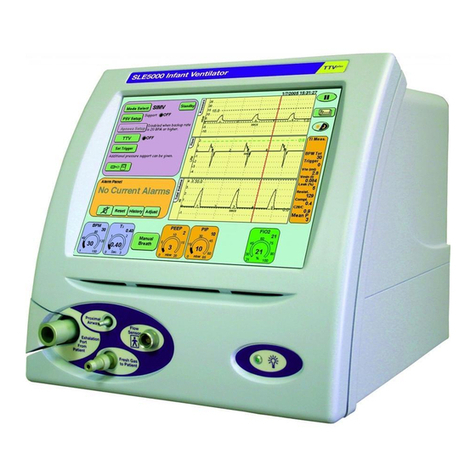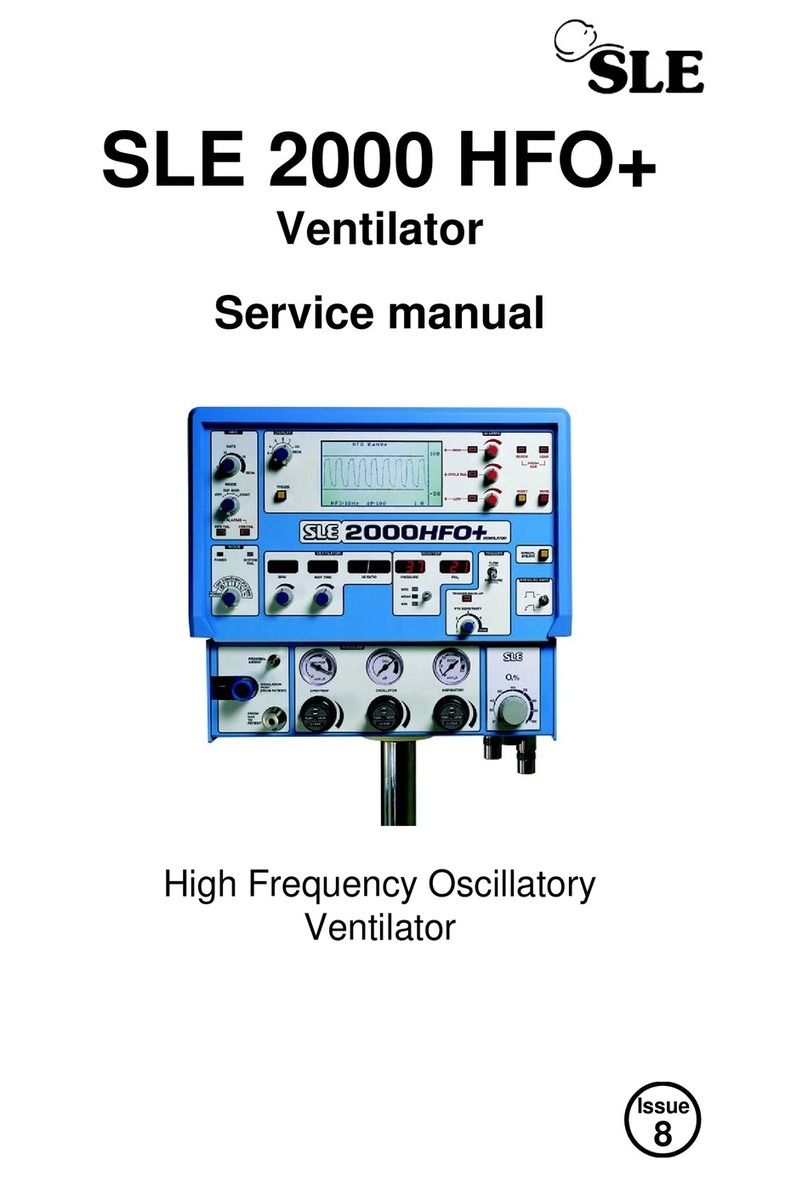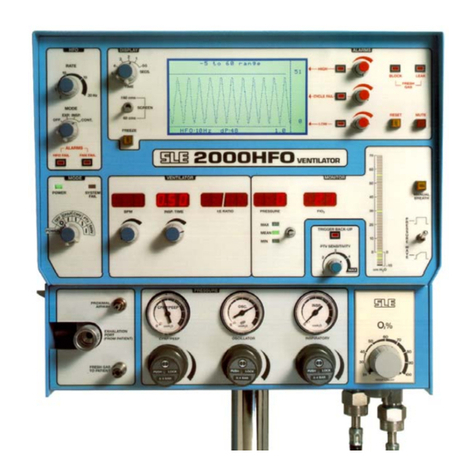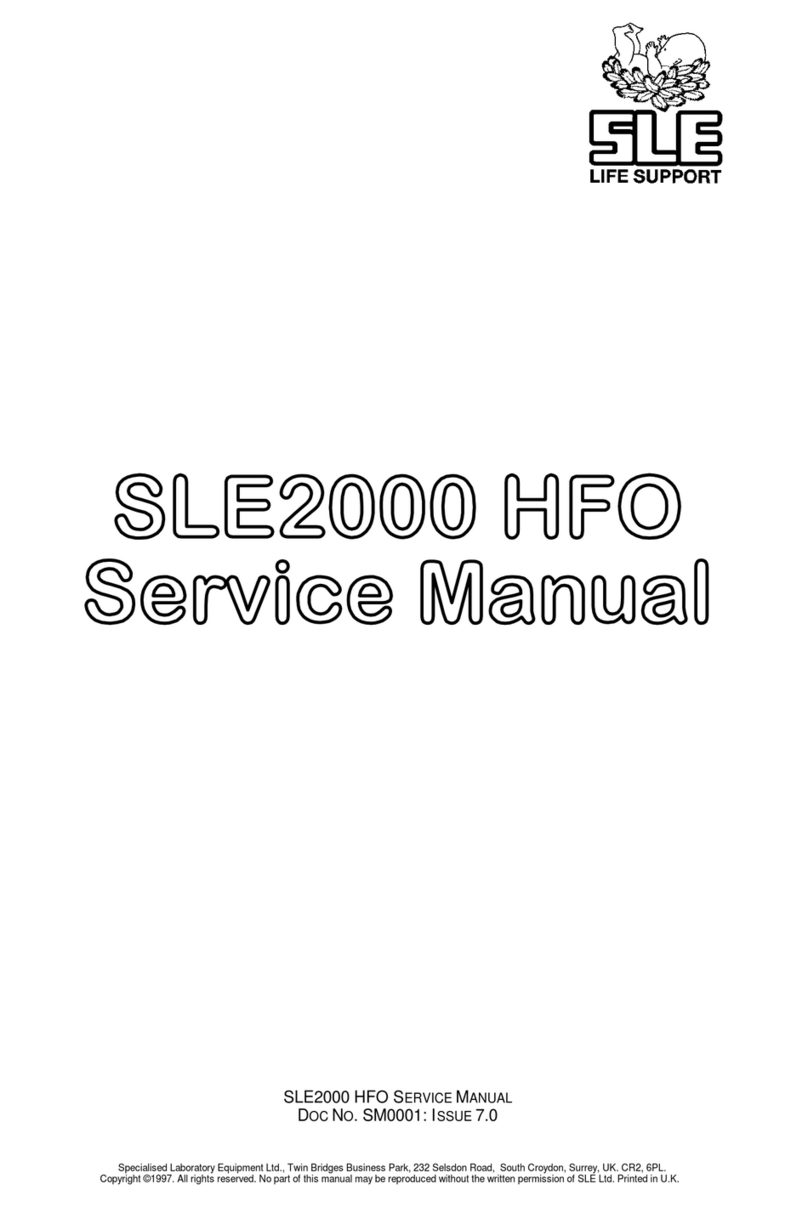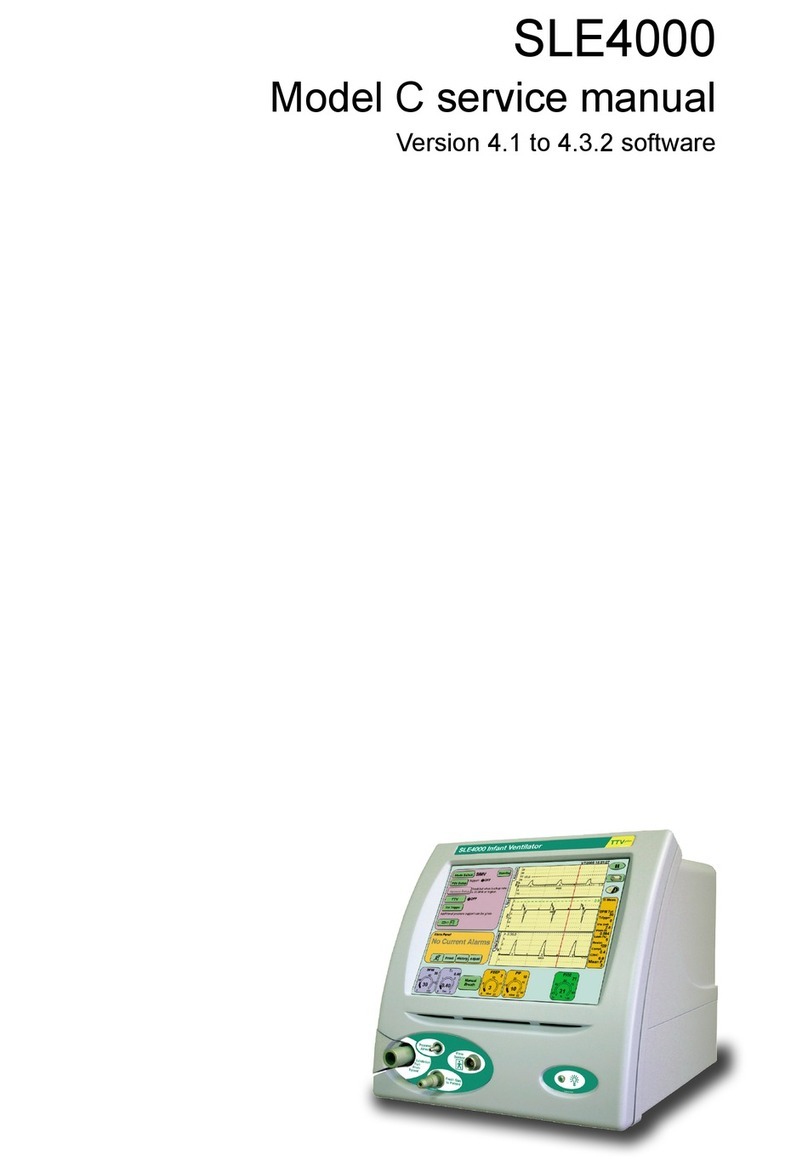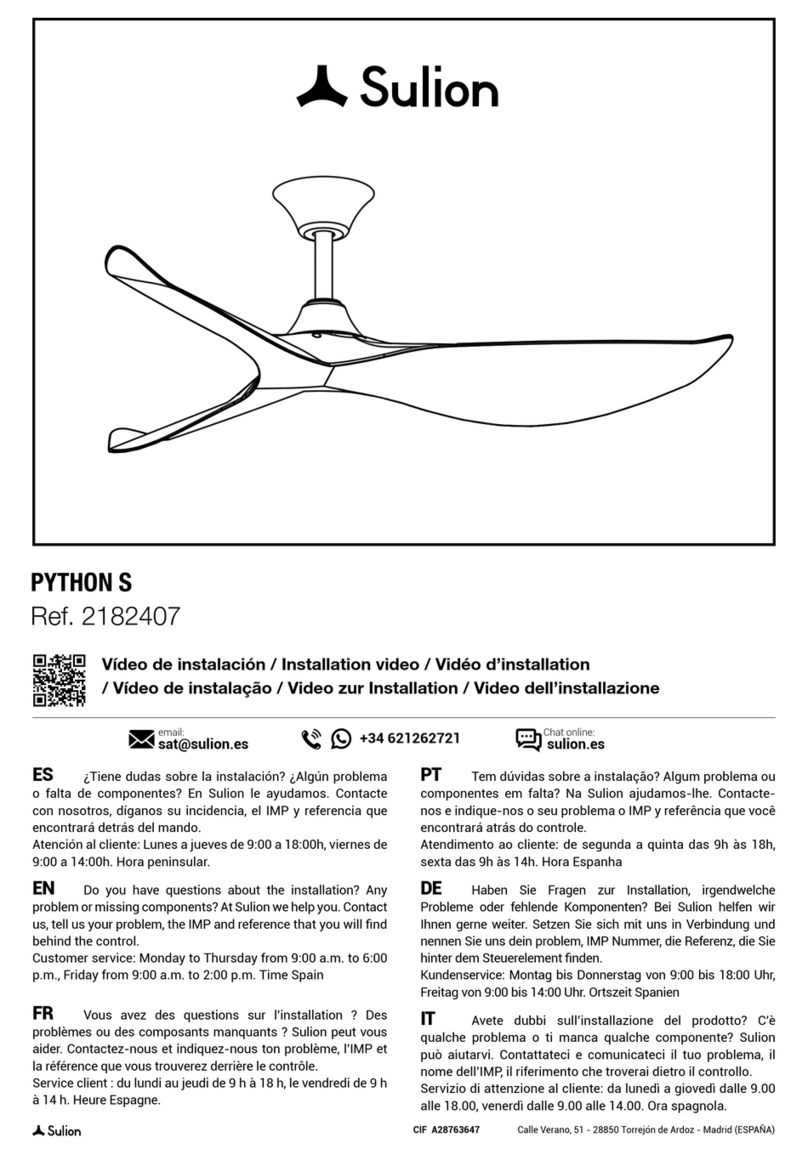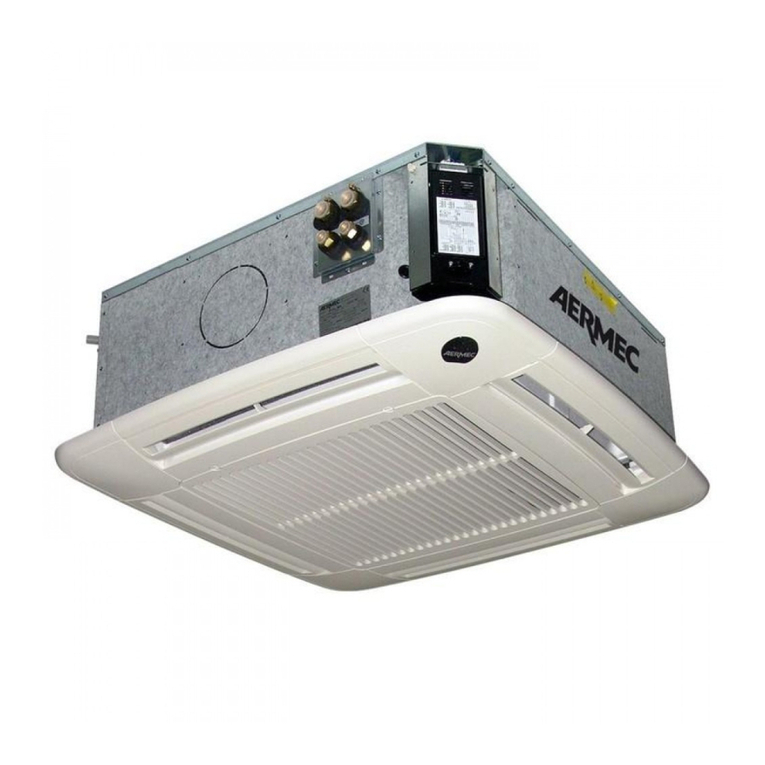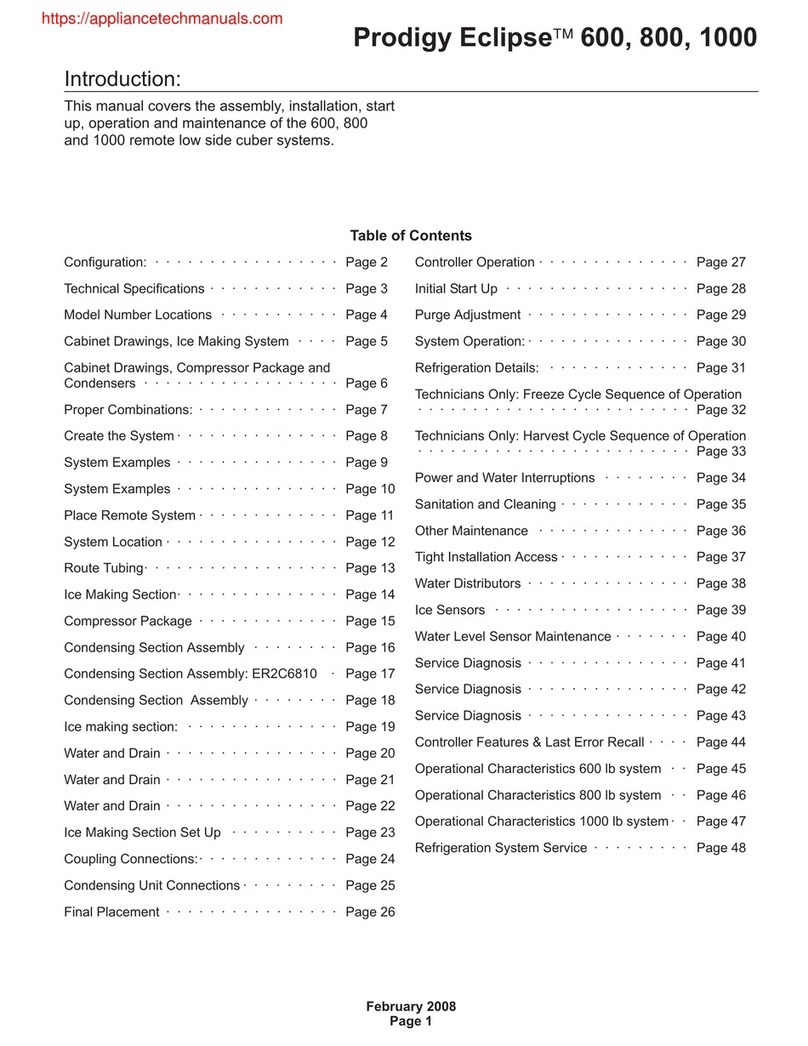SLE SLE4000 Model B User manual

SLE4000
Model K service manual
Version 4.3.1 & 4.3.2 software

Page 2 (Model K)
Software/Manual application Information:
Contact Information:
All rights reserved. No part of this publication may be reproduced, stored in any retrieval system, or transmitted
in any form or by any means, electronic, mechanical, photocopy, recording or otherwise, without prior
permission of SLE. © Copyright SLE 21/06/2011.
Manual: SM0032 Issue 2
SLE Part Nº: N6645/K .
Note: This manual is to be used only with models K ventilators using the following
software version:
Version 4.3.1 & 4.3.2
SLE Limited
Twin Bridges Business Park
232 Selsdon Road
South Croydon
Surrey CR2 6PL
Telephone: +44 (0)20 8681 1414
Service Fax: +44 (0)20 8649 4517
Web site: www.sle.co.uk

(Model K) Page 3
Contents
1. Warnings and Cautions ............................................................................................. 8
1.1. Warnings ........................................................................................................ 8
1.2. Cautions ......................................................................................................... 9
2. Principles of Operation .............................................................................................. 12
2.1. Electronic System........................................................................................... 12
2.2. Pneumatic System ......................................................................................... 13
3. Description of Symbols ............................................................................................. 16
4. Equipment list ........................................................................................................... 20
5. ENGMODE ............................................................................................................... 22
5.1. Accessing the Calibration Programs .............................................................. 22
5.2. Ventilator Calibration Program ....................................................................... 24
5.3. O2& Flow System Calibration........................................................................ 25
5.4. Reset Elapsed Time ....................................................................................... 26
5.5. Language Selection........................................................................................ 26
5.6. Activation of Language Selection Program form User Interface..................... 27
5.7. Exit ................................................................................................................. 27
5.8. Touch Screen Calibration Program ................................................................ 28
6. Component Replacement Procedure ........................................................................ 30
7. Preparing the SLE4000 ............................................................................................. 31
8. Component Replacement (Electronic unit) ............................................................... 33
8.1. N6631/21/CF/50 Compact Flash Card ........................................................... 33
8.2. N6631/LX800 PC Board................................................................................. 33
8.3. N6634/OEM2 CAN Card ................................................................................ 34
8.4. N6631/2216 Serial controller (Touch screen)................................................. 34
8.5. L0275/OEM2 Computer/Display Control assembly........................................ 35
8.6. A0763/4B Control/Monitor Board.................................................................... 36
8.7. M0915 Power Supply Unit.............................................................................. 37
8.8. M0901 Batteries ............................................................................................. 38
8.9. A0761 Transducer PCB Assembly................................................................. 39
8.10. N6631/13 Inverter PCB ................................................................................ 40
8.11. N6631/02 LCD & N6631/05 Touch Screen .................................................. 41
9. Component Replacement (Pneumatic unit) .............................................................. 43
9.1. Duckbill and conical filters. ............................................................................. 43
10. A0763/4B Monitor and control board ...................................................................... 52
10.1. A0763/4B board progammable devices ....................................................... 52
10.2. A0763/4B Board Hardware Identifier............................................................ 53
11. Electrical Safety Testing of the SLE4000 ................................................................ 57
12. PSU Testing ............................................................................................................ 61
13. Ventilator Power up and Power down. .................................................................... 64
14. Back-up Battery Charging ....................................................................................... 65

Page 4 (Model K)
14.1. Battery indicator ............................................................................................65
15. Extended storage ....................................................................................................67
16. Maintenance and Overhaul .....................................................................................70
16.1. Preventative Maintenance Kit .......................................................................70
16.2. 12 & 36 month preventative maintenance procedure ...................................72
16.3. 24 month and 48 month overhaul procedures ..............................................80
16.4. 24 month / 10,000 hour overhaul procedure.................................................82
16.5. 48 month / 20,000 hour overhaul procedure.................................................90
16.6. 48 month overhaul procedure using N9410/48/G overhaul kit......................92
17. Calibration Procedure for V4.3.1 & V4.3.2 software ................................................96
17.1. Equipment required for calibration. ...............................................................96
17.2. Preliminary Inspection before calibration ......................................................96
17.3. Pneumatic set up ..........................................................................................97
17.4. Calibration of Controller and Monitor subsystems ........................................100
17.5. Controller “Block and Leak” pressure sensor calibration ..............................102
17.6. Controller Blender Pressure Sensor zeroing and Input pressure reg. trim ...103
17.7. Mean Jet Pressure Regulator Calibration .....................................................104
17.8. Forward Jet Pressure Regulator Calibration.................................................106
17.9. Wave shaping for leading and trailing edge of insp. phase ..........................107
17.10. O2System Calibration ................................................................................108
17.11. Flow System Calibration .............................................................................108
17.12. Pressure Triggering Verification..................................................................108
17.13. Gas Fail Detection Verification....................................................................109
17.14. Blender and Oxygen Monitoring Verification...............................................110
17.15. Soak Test....................................................................................................111
17.16. Battery Charge Verification .........................................................................111
17.17. Total Power Fail Alarm Test........................................................................111
17.18. Pressure Calibration Verification.................................................................112
18. Functional Testing ...................................................................................................114
18.1. Ventilator setup .............................................................................................114
19. Trouble Shooting Chart ...........................................................................................142
20. Software Version History .........................................................................................152
21. Oxygen Calibration Routines ...................................................................................154
21.1. One point or 100% Oxygen system calibration.............................................154
21.2. Two point or 21% & 100% Oxygen system calibration .................................154
22. Alarms .....................................................................................................................156
22.1. Alarm Protocols.............................................................................................156
22.2. Alarm Sounds ...............................................................................................156
22.3. Alarm Descriptions and actions to be taken..................................................157
22.4. Software and System Fail Protocols .............................................................176
23. Cleaning, disinfection and sterilization ....................................................................177
23.1. Preparation of a new ventilator .....................................................................177
23.2. Cleaning and disinfection of an in-service ventilator.....................................177

(Model K) Page 5
23.3. Cleaning method .......................................................................................... 178
23.4. Disinfection method...................................................................................... 179
23.5. Sterilization method ...................................................................................... 180
24. Technical Specification ........................................................................................... 181
24.1. Operating Modes Conventional Ventilation .................................................. 181
24.2. Exhalation Block Port Jet Sizes.................................................................... 182
24.3. Measurement ............................................................................................... 186
24.4. Alarms .......................................................................................................... 187
24.5. Patient circuits .............................................................................................. 188
24.6. Outputs......................................................................................................... 189
24.7. Gas supplies................................................................................................. 190
24.8. Power, Dimensions, Classification etc.......................................................... 191
24.9. Classification ................................................................................................ 191
24.10. Environmental Storage Conditions............................................................. 191
25. EMC compliance ..................................................................................................... 192
25.1. Electromagnetic immunity ............................................................................ 193
25.2. Recommended separation distances between portable and mobile RF
communications equipment and the SLE4000...................................................... 195
26. Ventilator labelling ................................................................................................... 196
26.1. SLE4000....................................................................................................... 196
27. Electrical Block Diagram ......................................................................................... 198
28. L0288/KV Pneumatic Unit Layout & Schematic ...................................................... 199
28.1. Layout .......................................................................................................... 199
28.2. Schematic .................................................................................................... 200
29. Main Loom Circuit Diagram .................................................................................... 201
30. L0275/OEM2 Assembly Schematic ........................................................................ 202
31. A0761 circuit diagram ............................................................................................. 204
31.1. Transducer PCB Assembly .......................................................................... 204
32. A0763/4B circuit diagrams ...................................................................................... 206
32.1. Micro Controller ............................................................................................ 206
32.2. Conventional Valve Drive ............................................................................. 207
32.3. Power Distribution And Hardware Identifier.................................................. 208
32.4. Analogue Valve Drive / Non Volatile Memory / Interboard Comms.............. 209
32.5. High Speed Valve Drive ............................................................................... 210
32.6. Analogue Data acquisition/Monitor port........................................................ 211
32.7. Control & Monitor, PCB PSU Circuit............................................................. 212
32.8. Control & Monitor, Micro Non-isolated.......................................................... 213
32.9. Control & Monitor, Micro Isolated ................................................................. 214
32.10. Control & Monitor, Analog Isolated............................................................. 215
32.11. Control & Monitor, Alarm Controller............................................................ 216
33. Illustrated Parts List ................................................................................................ 218
Ventilator assembly .............................................................................................. 220

Page 6 (Model K)
Base plate and side door assembly ......................................................................227
Front facia assembly .............................................................................................229
Electronic module .................................................................................................231
Pneumatic module ................................................................................................252
DISS air and oxygen fittings ..................................................................................264
34. Equipotential stud modification ................................................................................268
34.1. Equipotential stud connection .......................................................................269
Appendix 1. Calibration Checklist ..................................................................................273
Appendix 2. Check list ...................................................................................................281
Appendix 3. TB & SI Index ............................................................................................286
35. Technical Bulletin & Service Information Letters .....................................................286
35.1. Service Information letters ............................................................................286
35.2. Technical Bulletins ........................................................................................288
Appendix 4. ...................................................................................................................290
36. RS232 .....................................................................................................................290
36.1. Warnings for RS232......................................................................................290
36.2. Location of RS232 Port.................................................................................290
36.3. Overview .......................................................................................................291
36.4. Data and Pinout description..........................................................................291
36.5. Cable.............................................................................................................291
36.6. Parameter Descriptions and format ..............................................................292
36.7. List of parameters .........................................................................................292
36.8. Table of current alarm condition codes.........................................................295
36.9. RS232 Connection Settings and Testing Data Output..................................297
36.10. Glossary......................................................................................................297
Appendix 5. VueLink .....................................................................................................300
37. VueLink Technical Data ..........................................................................................300
37.1. Glossary........................................................................................................300
37.2. Connecting the SLE4000 to the VueLink patient monitor .............................300
37.3. Parameter Descriptions ................................................................................301
37.4. Data transferred to the VueLink system from the SLE4000..........................302
37.5. Alarm and inoperative indications .................................................................304
37.6. VueLink Task Window Layout.......................................................................307
37.7. Notes on General System Behaviour............................................................308
37.8. Activation of VueLink ....................................................................................309
37.9. Disabling VueLink. ........................................................................................310

(Model K) Page 7
Warnings and Cautions

Page 8 (Model K)
1. Warnings and Cautions
1.1 Warnings
1. The electronic and pneumatic units of the SLE4000 infant ventilator are sealed at the
factory with two Warranty Void If Label Broken seals. If the ventilator is subject to a
warranty agreement do not attempt to carry out any procedure that would involve
breaking these seals. If you make a warranty claim and these seals are broken SLE
may deem the warranty claim null and void. If the ventilator develops a fault within the
warranty period please refer to your warranty documentation.
2. Oxygen - Fire Hazard. Oxygen vigorously supports combustion and its use requires
special precaution to avoid fire hazards. Keep all sources of ignition away when oxygen
is in use. Do not use oil or grease on oxygen fittings or where oxygen is used.
3. Check the condition of the gas supply hoses to the ventilator. Do not use any hose that
shows signs of cracking, abrasion, kinking, splits, excessive wear or ageing. Make sure
that the Air or O2hose has not come into contact with oil or grease.
4. The SLE4000 ventilator contains temperature dependant devices which perform
normally in controlled environments in hospitals. However if the ventilator has been
stored at a temperature different to that in which it will be used, allow the unit to
acclimatize before powering up.
5. Failure to comply with the recommended service programs could lead to injury of the
patient, operator or damage to the ventilator. It is the owners responsibility to ensure
that the equipment is regularly maintained.
6. The SLE4000 contains static sensitive electrical devices. Anti static precuations must be
observed at all time when working on the ventilator.
7. Disconnect the ventilator from the mains supply. Use an earthing strap to earth the
ventilator.

(Model K) Page 9
1.2 Cautions
1. When working on the pnuematic unit, protect the front facia panel by resting it on a soft
pad.
2. Do not use a sharp instrument, such as a pen to activate the controls as the excessive
pressure applied by the point will damage the touch screen membrane.
3. The Ventilator must be connected to a suitably rated and grounded electrical power
source.
4. If the SLE4000 is adversely affected by equipment emitting electromagnetic interference
then that equipment should be switched off or removed from the vicinity of the SLE4000.
Conversely, if the SLE4000 is the source of interference to other neighbouring
equipment, it should be switched off or taken to another location.
5. The functioning of this machine may be adversely affected by the operation of
equipment such as high frequency surgical (diathermy) equipment, defibrillators, mobile
phones or short-wave therapy equipment in the vicinity.
8. The equipment is not suitable for use with, or in the presence of flammable anaesthetic
mixtures.
6. The SLE4000 flow monitoring system is calibrated to work in an air / oxygen mixture, the
use of other gas mixtures may affect the flow monitoring accuracy of the ventilator.
7. Disposal of the Oxygen Sensor should be in accordance with local regulations for
hazardous substances. Do not incinerate. SLE offer a cell disposal service.
8. The ventilator must have its batteries charged every 14 days. The ventilator must be
connected to a mains power source for 24 hours to ensure a full charge. Failure to
charge the batteries will shorten the service life of the batteries which will result in
reduced battery life in a mains power fail situation.
9. If the ventilator is operating on battery power and allowed to completely discharge the
battery, it should be recharged a soon as possible. This is to avoid damaging the
batteries by allowing them to remain in a deep discharged state for any period of time.
Allowing the batteries to remain in the deep discharged state will shorten the life of the
batteries and the amount of time the ventilator can remain on battery power.
10. If the ventilator is not going to be used for a period in excess of 40 days then disconnect
the batteries from the power supply. (See “Extended storage” on page 67.)

Page 10 (Model K)
11. The SLE4000 contains several batteries, three 2 cell sealed lead acid batteries and 2
AA alkaline batteries. At the end of their useful life these batteries should be disposed of
in accordance with local authority guidelines.
12. Apart from the batteries, the ventilator and accessories do not contain any hazardous
components therefore no special precautions are required for their disposal. The
ventilator should be disposed of in accordance to the local WEEE (Waste Electrical and
Electronic Equipment) guidelines.
13. Care should be taken when attaching other equipment as this may affect mechanical
stability.
14. Any computer connected to the ventilator must be specified for medical use (ie. it must
comply with the requirements of BS-EN-60601:1990).
15. There is no special protection provided against ingress of water or liquids.
16. Do not use solvent based cleaning solutions to clean the touch screen or covers.

(Model K) Page 11
Principles of Operation

Page 12 (Model K)
2. Principles of Operation
The SLE4000 infant ventilator consists of an electronic system in the upper section of the
ventilator and a pneumatic system in the lower.
2.1 Electronic System
The electronic system comprises three autonomous subsystems, one responsible for
monitoring the patient, one responsible for controlling the valves of the pneumatic system
and one for the user interface (touchscreen and displayed data). They are connected
together by three serial communication links in a delta configuration.
The ventilator has an internal battery that can power the ventilator in the event of a mains
power fail. If the mains power fails with the battery fully charged, then operation will continue
for 30 to 60 minutes depending on ventilation mode.
See “Electrical Block Diagram” on page 198.

(Model K) Page 13
2.2 Pneumatic System
The pneumatic system comprises of the tubing and electro-mechanical valves necessary to
provide the gas in conventional ventilation modes. The two gas controlling functions are
blending and pressure generation
2.2.1 Blending
The method used for blending air and oxygen in known proportions is to pressure regulate
the two supplies (air and oxygen) so they produce equal flow rates and then allow each
supply into a mixing chamber for a time period equivalent to the proportions required. For
example, delivering oxygen at a set flow rate into a mixing chamber for 1 second and air at
the same flow rate for 2 seconds will result in a mixture of 1 part oxygen to 2 parts air
(resulting in a mix of 47.3%).
2.2.2 Pressure Generation
There are three nozzles within the exhalation block in the pneumatic subsystem. One for
generating negative pressure in the patient circuit and the other two for generating positive
pressure. The positive pressures nozzles are controlled by two electronically controlled
pressure regulators. The negative nozzle is controlled by an electronically controlled
solenoid valve.
The other positive nozzle (the mean jet) is used to generate steady pressures in ventilation
(CPAP or PEEP pressures). These three nozzles (or jets) are used in various combinations
to generate all ventilation modes.
2.2.3 Conventional ventilation
The negative (or reverse) jet is used in a steady mode to provide a small amount of flow to
offset the inadvertent patient circuit pressure generated from the fresh gas flow of 8 lpm. The
mean jet is also used in a steady mode to generate the base pressure level (CPAP or PEEP)
and the forward jet is used to generate the PIP pressure during the inspiratory phase. The
rise time of the inspiratory phase is controlled by dynamically controlling the forward jet
pressure regulator.
This provides a smooth rise in pressure and allows user adjustable rise times. The fall of the
inspiratory wave is also controlled by the forward jet pressure regulator to bring the pressure
down quickly and smoothly. Once the pressure has been brought close to the base pressure,
after about 100 ms, the forward jet solenoid is switched off to prevent any further artefact
causing false triggering.
Note that all jet pressures actually sum in the exhalation block, for example, to ventilate a
patient with a PEEP pressure of 5 mbar and a PIP pressure of 30 mbar, the mean jet will be
set to generate a continuous circuit pressure of 5 mbar and the forward jet will be set to
generate a circuit pressure varying between zero (exp phase) and 25 mbar (insp. phase).
Since the jet pressures will sum, this will result in the desired patient pressure.
See “Pneumatic Unit Schematic” on page 199.

Page 14 (Model K)
This page is intentionally blank.

(Model K) Page 15
Description of Symbols

Page 16 (Model K)
3. Description of Symbols
Symbol Description
Type BF connection (Situated on front panel)
Read manual (Situated on rear panel)
Date of Manufacture (Appears on serial number label)
Do not dispose of as general waste (WEEE directive)
(Appears on serial number label)
EEC conformity marking showing compliance with the Medical
Devices Directive (Appears on serial number label)
Indicates the mains power switch
Mains power present, (Situated on front panel)
Indicates a warning in the manual
Observe anti static precautions

(Model K) Page 17
Indicates a note in the manual
Indicates a caution in the manual
Check list item.
Symbol Description

Page 18 (Model K)
This page is intentionally blank.

(Model K) Page 19
Equipment List

Page 20 (Model K)
4. Equipment list
To service the SLE4000 infant ventilator the service personnel will require the following
equipment. Items marked with an SLE part number can be obtained by contacting the
service department.
•Electronic engineers tool kit.
•a/b Calibration analyser (calibrated in mbar) .......SLE Part Nº: N2830
•a Patient circuit ....................................................SLE Part Nº: BC5188/100 or /400
•a Humidification chamber (Typically MR225) ......SLE Part Nº: N3220
•b Test lung ...........................................................SLE Part Nº: N6647
•cFoam support pad
•a Digital Multimeter (1mv resolution)
•aCalibration kit....................................................SLE Part Nº: N9025
Which contains the following:
Block and leak Y piece assy. ..... Qty 1
Flow tubing assembly ................ Qty 1
Internal pressure tubing kit ........ Qty 1
Y piece Kit .................................. Qty 1
Dummy load kit .......................... Qty 1
Tygon tubing 3/8" x 9/16" ........... Qty 600mm
•cStatic protection wrist band
•cAnti-static protective bags (300mm x 300mm)
•a Flow sensor cable.............................................SLE Part Nº: N6635
•a Flow sensor ......................................................SLE Part Nº: N5201 or N5301
•a Exhalation block ...............................................SLE Part Nº: N6622
•a Oxygen supply
•a Air supply
•a Earthing strap
aNote all items marked with an ‘a’ are required for servicing and overhaul. Without these
items the user will be unable to service or overhaul the SLE4000 ventilator.
bNote items marked with a ‘b’ are required to carry out the functional testing routine.
Other manuals for SLE4000 Model B
1
Table of contents
Other SLE Fan manuals
Popular Fan manuals by other brands

Dimplex
Dimplex DCPFQ35 instruction manual

Home Decorators Collection
Home Decorators Collection CHELTON 46-MDL Use and care guide
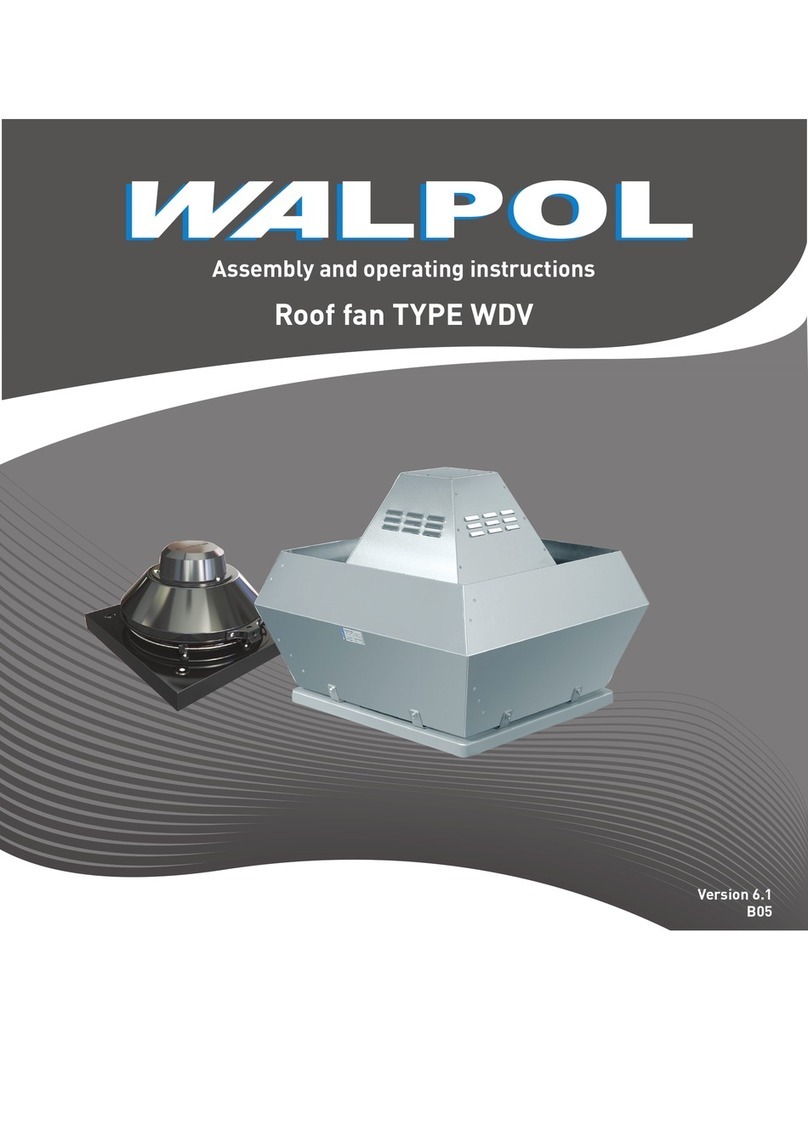
WALPOL
WALPOL WDV-A 355 EC Assembly and operating instructions

Panasonic
Panasonic FY-150ZDY8 Operation instructions
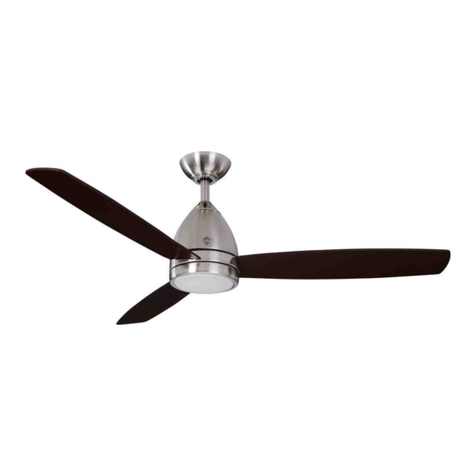
GE
GE 20772 user manual

Goldair
Goldair GCDF051 operating instructions
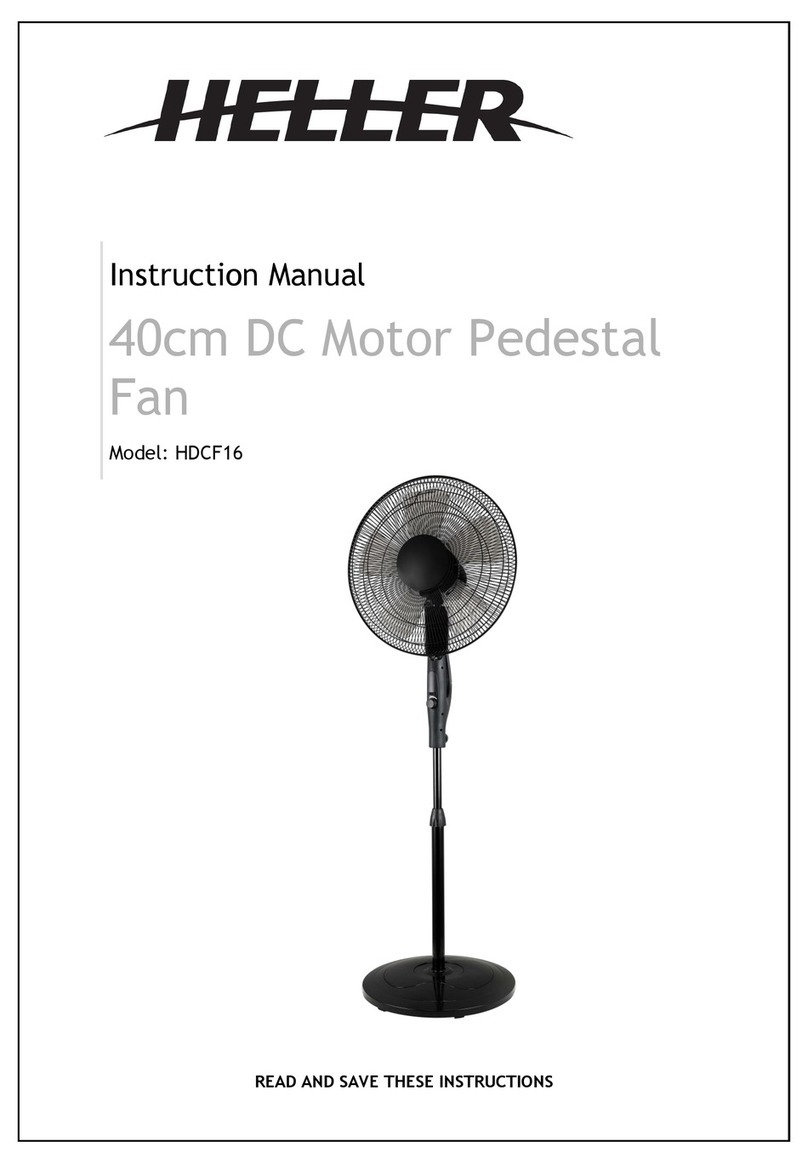
HELLER
HELLER HDCF16 instruction manual
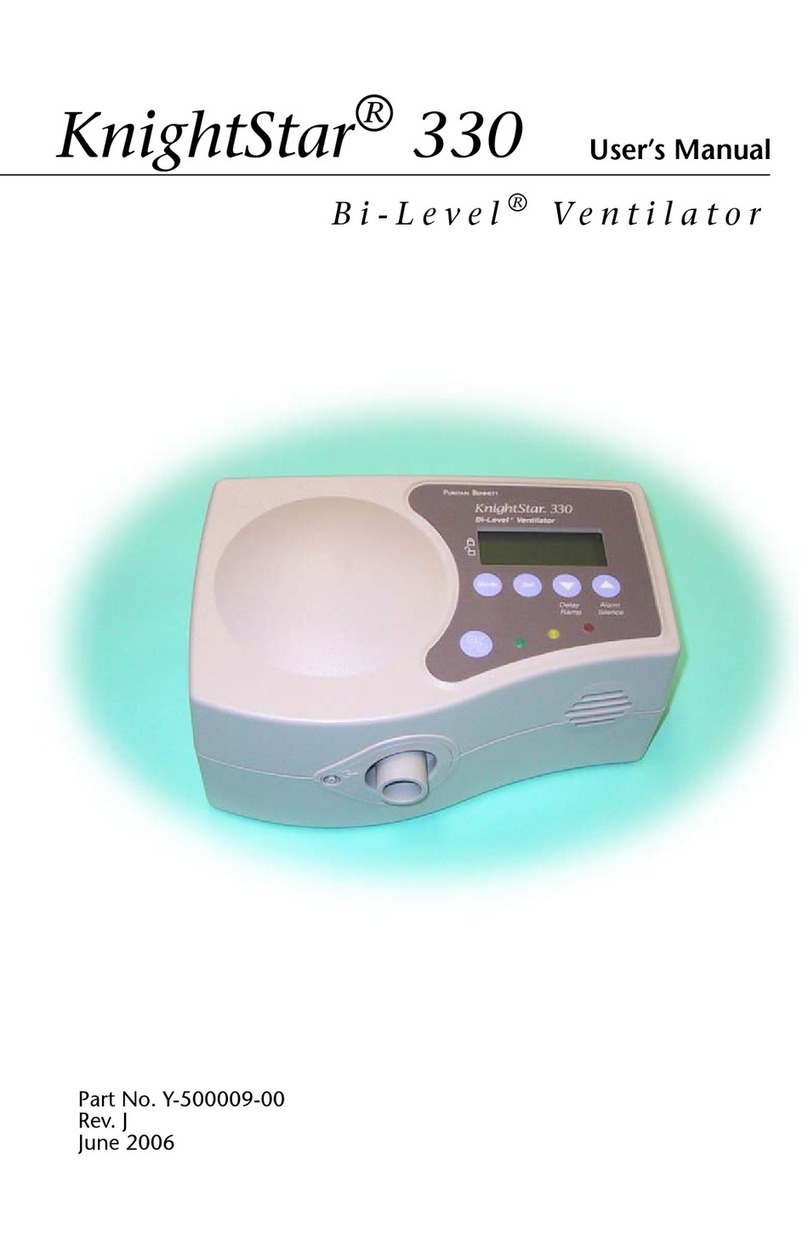
Puritan Bennett
Puritan Bennett KnightStar 330 user manual

Casablanca
Casablanca Lanai owner's manual
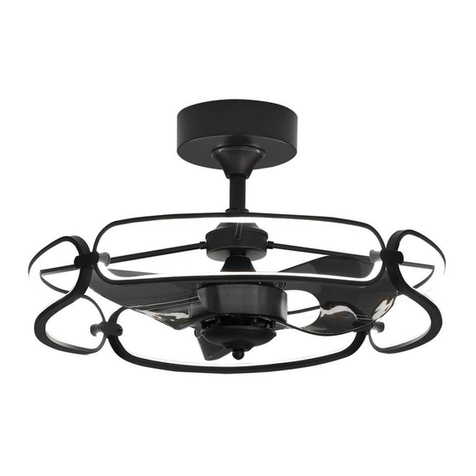
Lumirama
Lumirama DELPHINA installation guide
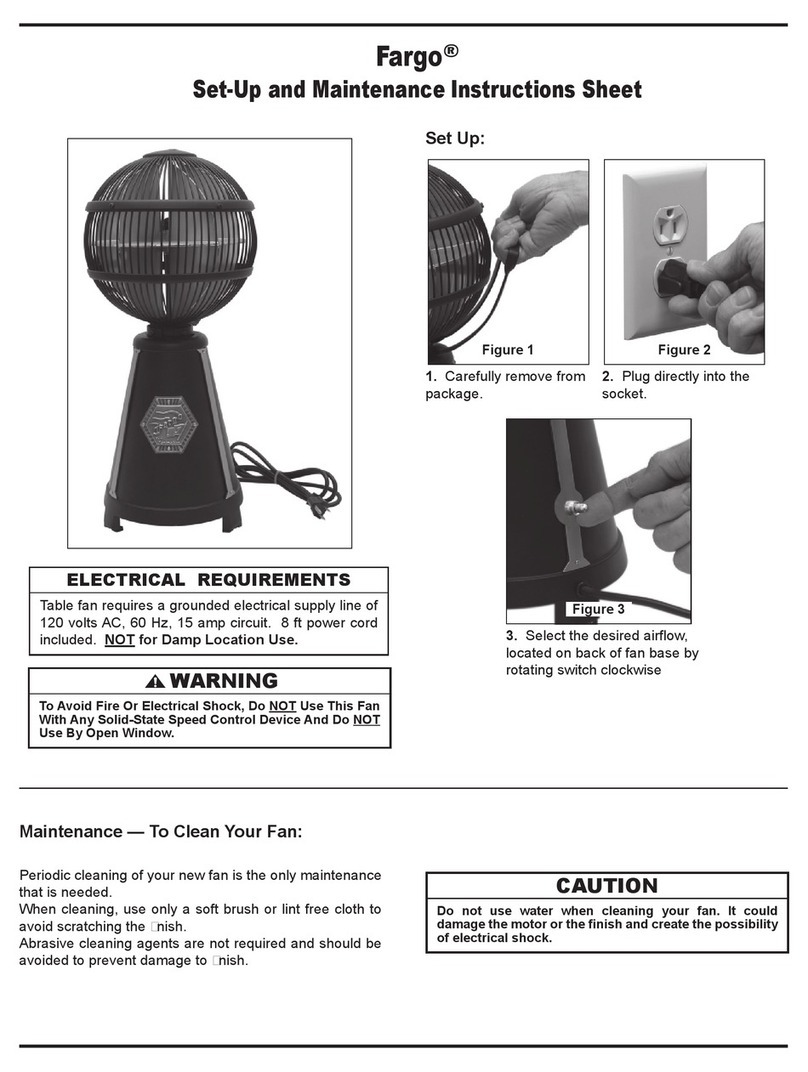
Fargo
Fargo FP3320BG Set-up and maintenance instructions sheet
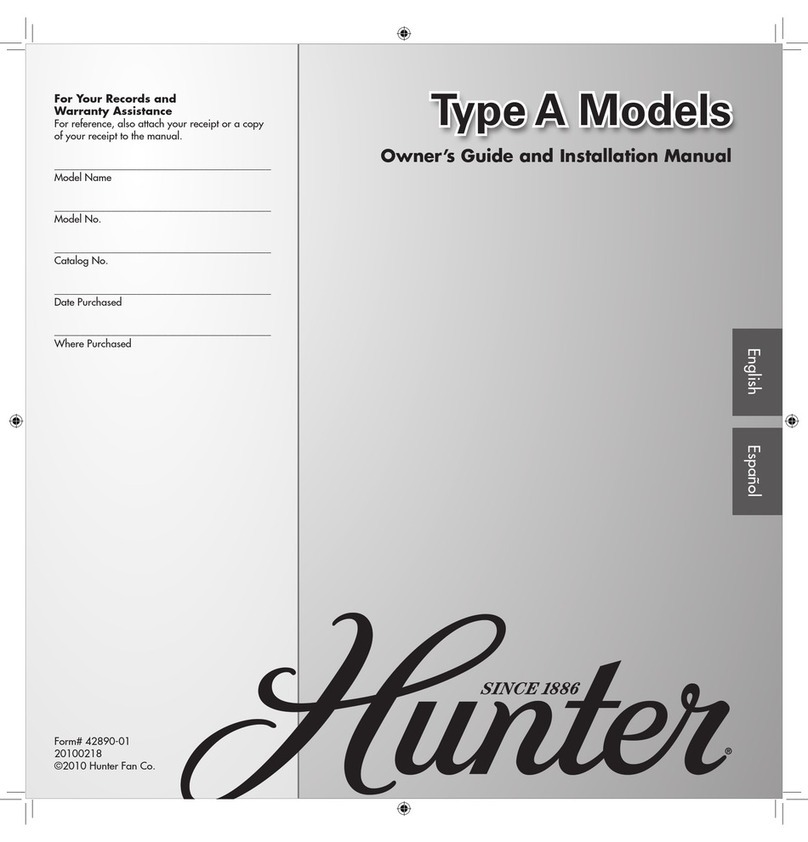
Hunter
Hunter 42890-01 Owner's guide and installation manual
